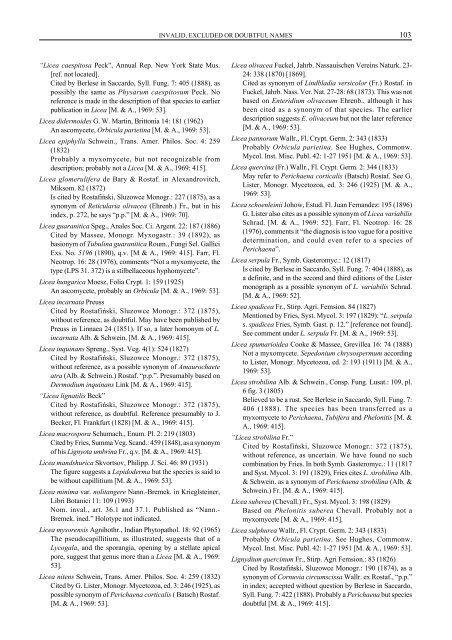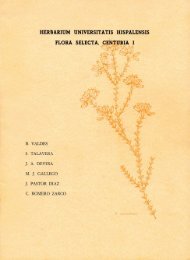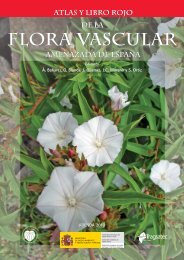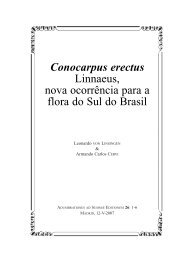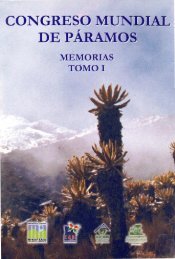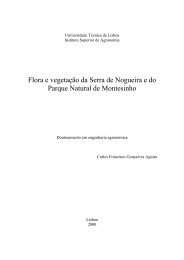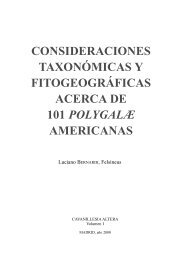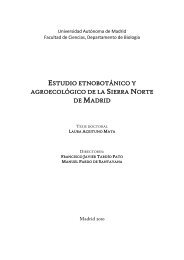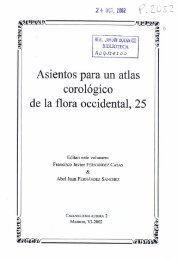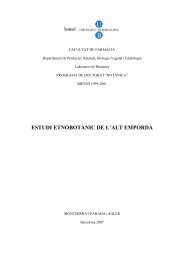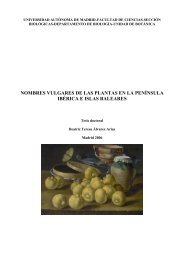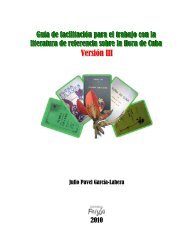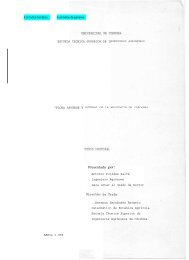Primera de cubierta.qxd - Biblioteca digital del Real Jardín Botánico ...
Primera de cubierta.qxd - Biblioteca digital del Real Jardín Botánico ...
Primera de cubierta.qxd - Biblioteca digital del Real Jardín Botánico ...
Create successful ePaper yourself
Turn your PDF publications into a flip-book with our unique Google optimized e-Paper software.
“Licea caespitosa Peck”, Annual Rep. New York State Mus.<br />
[ref. not located].<br />
Cited by Berlese in Saccardo, Syll. Fung. 7: 405 (1888), as<br />
possibly the same as Physarum caespitosum Peck. No<br />
reference is ma<strong>de</strong> in the <strong>de</strong>scription of that species to earlier<br />
publication in Licea [M. & A., 1969: 53].<br />
Licea di<strong>de</strong>rmoi<strong>de</strong>s G. W. Martin, Brittonia 14: 181 (1962)<br />
An ascomycete, Orbicula parietina [M. & A., 1969: 53].<br />
Licea epiphylla Schwein., Trans. Amer. Philos. Soc. 4: 259<br />
(1832)<br />
Probably a myxomycete, but not recognizable from<br />
<strong>de</strong>scription; probably not a Licea [M. & A., 1969: 415].<br />
Licea glomerulifera <strong>de</strong> Bary & Rostaf. in Alexandrovitch,<br />
Miksom. 82 (1872)<br />
Is cited by Rostafiński, Sluzowce Monogr.: 227 (1875), as a<br />
synonym of Reticularia olivacea (Ehrenb.) Fr., but in his<br />
in<strong>de</strong>x, p. 272, he says “p.p.” [M. & A., 1969: 70].<br />
Licea guaranitica Speg., Anales Soc. Ci. Argent. 22: 187 (1886)<br />
Cited by Massee, Monogr. Myxogastr.: 39 (1892), as<br />
basionym of Tubulina guaranitica Roum., Fungi Sel. Gallici<br />
Exs. No. 5196 (1890), q.v. [M & A., 1969: 415]. Farr, Fl.<br />
Neotrop. 16: 28 (1976), comments “Not a myxomycete, the<br />
type (LPS 31. 372) is a stilbellaceous hyphomycete”.<br />
Licea hungarica Moesz, Folia Crypt. 1: 159 (1925)<br />
An ascomycete, probably an Orbicula [M. & A., 1969: 53].<br />
Licea incarnata Preuss<br />
Cited by Rostafiński, Sluzowce Monogr.: 372 (1875),<br />
without reference, as doubtful. May have been published by<br />
Preuss in Linnaea 24 (1851). If so, a later homonym of L.<br />
incarnata Alb. & Schwein. [M. & A., 1969: 415].<br />
Licea inquinans Spreng., Syst. Veg. 4(1): 524 (1827)<br />
Cited by Rostafiński, Sluzowce Monogr.: 372 (1875),<br />
without reference, as a possible synonym of Amaurochaete<br />
atra (Alb. & Schwein.) Rostaf. “p.p.”. Presumably based on<br />
Dermodium inquinans Link [M. & A., 1969: 415].<br />
“Licea lignatilis Beck”<br />
Cited by Rostafiński, Sluzowce Monogr.: 372 (1875),<br />
without reference, as doubtful. Reference presumably to J.<br />
Becker, Fl. Frankfurt (1828) [M. & A., 1969: 415].<br />
Licea macrospora Schumach., Enum. Pl. 2: 219 (1803)<br />
Cited by Fries, Summa Veg. Scand.: 459 (1848), as a synonym<br />
of his Lignyota umbrina Fr., q.v. [M. & A., 1969: 415].<br />
Licea mandshurica Skvortsov, Philipp. J. Sci. 46: 89 (1931)<br />
The figure suggests a Lepido<strong>de</strong>rma but the species is said to<br />
be without capillitium [M. & A., 1969: 53].<br />
Licea minima var. nolitangere Nann.-Bremek. in Krieglsteiner,<br />
Libri Botanici 11: 109 (1993)<br />
Nom. inval., art. 36.1 and 37.1. Published as “Nann.-<br />
Bremek. ined.” Holotype not indicated.<br />
Licea mysorensis Agnihothr., Indian Phytopathol. 18: 92 (1965)<br />
The pseudocapillitium, as illustrated, suggests that of a<br />
Lycogala, and the sporangia, opening by a stellate apical<br />
pore, suggest that genus more than a Licea [M. & A., 1969:<br />
53].<br />
Licea nitens Schwein, Trans. Amer. Philos. Soc. 4: 259 (1832)<br />
Cited by G. Lister, Monogr. Mycetozoa, ed. 3: 246 (1925), as<br />
possible synonym of Perichaena corticalis ( Batsch) Rostaf.<br />
[M. & A., 1969: 53].<br />
INVALID, EXCLUDED OR DOUBTFUL NAMES<br />
103<br />
Licea olivacea Fuckel, Jahrb. Nassauischen Vereins Naturk. 23-<br />
24: 338 (1870) [1869].<br />
Cited as synonym of Lindbladia versicolor (Fr.) Rostaf. in<br />
Fuckel, Jahrb. Nass. Ver. Nat. 27-28: 68 (1873). This was not<br />
based on Enteridium olivaceum Ehrenb., although it has<br />
been cited as a synonym of that species. The earlier<br />
<strong>de</strong>scription suggests E. olivaceum but not the later reference<br />
[M. & A., 1969: 53].<br />
Licea pannorum Wallr., Fl. Crypt. Germ. 2: 343 (1833)<br />
Probably Orbicula parietina. See Hughes, Commonw.<br />
Mycol. Inst. Misc. Publ. 42: 1-27 1951 [M. & A., 1969: 53].<br />
Licea quercina (Fr.) Wallr., Fl. Crypt. Germ. 2: 344 (1833)<br />
May refer to Perichaena corticalis (Batsch) Rostaf. See G.<br />
Lister, Monogr. Mycetozoa, ed. 3: 246 (1925) [M. & A.,<br />
1969: 53].<br />
Licea schoenleinii Johow, Estud. Fl. Juan Fernan<strong>de</strong>z: 195 (1896)<br />
G. Lister also cites as a possible synonym of Licea variabilis<br />
Schrad. [M. & A., 1969: 52]. Farr, Fl. Neotrop. 16: 28<br />
(1976), comments it “the diagnosis is too vague for a positive<br />
<strong>de</strong>termination, and could even refer to a species of<br />
Perichaena”.<br />
Licea serpula Fr., Symb. Gasteromyc.: 12 (1817)<br />
Is cited by Berlese in Saccardo, Syll. Fung. 7: 404 (1888), as<br />
a <strong>de</strong>finite, and in the second and third editions of the Lister<br />
monograph as a possible synonym of L. variabilis Schrad.<br />
[M. & A., 1969: 52].<br />
Licea spadicea Fr., Stirp. Agri. Femsion. 84 (1827)<br />
Mentioned by Fries, Syst. Mycol. 3: 197 (1829): “L. serpula<br />
s. spadicea Fries, Symb. Gast. p. 12.” [reference not found].<br />
See comment un<strong>de</strong>r L. serpula Fr. [M. & A., 1969: 53].<br />
Licea spumarioi<strong>de</strong>a Cooke & Massee, Grevillea 16: 74 (1888)<br />
Not a myxomycete. Sepedonium chrysospermum according<br />
to Lister, Monogr. Mycetozoa, ed. 2: 193 (1911) [M. & A.,<br />
1969: 53].<br />
Licea strobilina Alb. & Schwein., Consp. Fung. Lusat.: 109, pl.<br />
6 fig. 3 (1805)<br />
Believed to be a rust. See Berlese in Saccardo, Syll. Fung. 7:<br />
406 (1888). The species has been transferred as a<br />
myxomycete to Perichaena, Tubifera and Phelonitis [M. &<br />
A., 1969: 415].<br />
“Licea strobilina Fr.”<br />
Cited by Rostafiński, Sluzowce Monogr.: 372 (1875),<br />
without reference, as uncertain. We have found no such<br />
combination by Fries. In both Symb. Gasteromyc.: 11 (1817<br />
and Syst. Mycol. 3: 191 (1829), Fries cites L. strobilina Alb.<br />
& Schwein. as a synonym of Perichaena strobilina (Alb. &<br />
Schwein.) Fr. [M. & A., 1969: 415].<br />
Licea suberea (Chevall.) Fr., Syst. Mycol. 3: 198 (1829)<br />
Based on Phelonitis suberea Chevall. Probably not a<br />
myxomycete [M. & A., 1969: 415].<br />
Licea sulphurea Wallr., Fl. Crypt. Germ. 2: 343 (1833)<br />
Probably Orbicula parietina. See Hughes, Commonw.<br />
Mycol. Inst. Misc. Publ. 42: 1-27 1951 [M. & A., 1969: 53].<br />
Lignydium quercinum Fr., Stirp. Agri Femsion.: 83 (1826)<br />
Cited by Rostafiński, Sluzowce Monogr.: 190 (1874), as a<br />
synonym of Cornuvia circumscissa Wallr. ex Rostaf., “p.p.”<br />
in in<strong>de</strong>x; accepted without question by Berlese in Saccardo,<br />
Syll. Fung. 7: 422 (1888). Probably a Perichaena but species<br />
doubtful [M. & A., 1969: 415].


